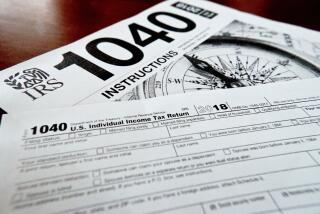Filing Returns Grows Increasingly Taxing
WASHINGTON — Half a million taxpayers paid the government at least $311 million more than necessary in 1998 because they took the simpler standard deduction instead of trying to itemize.
That’s only one sign of the increasingly complicated task Americans face if they attempt to fill out federal tax forms by themselves. It’s also a reason more people are turning to professionals to do their taxes and business is booming for tax-preparation software and Internet sites.
Millions of taxpayers will finish their returns this week to meet Monday’s midnight deadline for most people.
The bewildering complexity of tax law, says the Internal Revenue Service’s own taxpayer advocate, “continues to be the most serious and burdensome problem facing America’s taxpayers.”
“The most basic aspects of tax law are complicated and contain exceptions and special rules that many taxpayers do not understand,” continues the IRS advocate’s recent report to Congress.
Some people decide to settle for only the most basic forms. In an unpublished draft report, the General Accounting Office discovered that in 1998, more than 510,000 taxpayers who chose to take the standard deduction could have gotten a bigger deduction by itemizing because they had mortgage interest payments.
The GAO, which is the investigative arm of Congress, estimated that these people paid the IRS $311 million more than they should have--an average of $610 each.
David Keating, senior counselor at the National Taxpayers Union, a tax watchdog group that advocates lower taxes and taxpayer rights, pointed out several trends that show how difficult doing one’s own taxes has become:
* In 1945, the instructions for the basic 1040 income tax form ran all of four pages. Ten years later, they ran 16 pages and by 1985 had reached 52 pages. This year, the booklet is 117 pages long.
* About 58% of taxpayers will hire a paid preparer to do their taxes this year. In 1980, the figure was 38%. Combined with computer-prepared returns, at least three-quarters of taxpayers will seek professional help in completing their taxes this year. Through April 6, more than 5 million people had filed returns using their home computer--almost 36% more than last year.
* Four basic individual tax forms--the 1040 form and Schedules A, B and D--now require more than 27 hours of a taxpayer’s total time, according to IRS estimates. That’s up from just under 18 hours in 1988.
Another way of looking at complexity is by examining the fees taxpayers are charged by professionals such as H&R; Block, which prepares about one in seven individual tax returns. Adjusted for inflation, Block’s fees on average have risen from more than $75 in 1985 to $108.80 through March 31. The fees are based in part on the number of forms and time it takes to prepare a return.
There are a host of reasons this has happened, but most result from decisions made by Congress in the tax bills that pass almost every year.
For instance, lawmakers have created a $500 child tax credit, a child-care credit, education credits, personal exemptions for dependents and adoption credits.
To contain costs or reduce perceptions that tax cuts help upper-income people, Congress frequently limits a tax break to taxpayers of certain incomes.
For example, the $500 child tax credit is reduced by $50 for every $1,000 in income a married couple filing jointly earns above $110,000 in adjusted gross income, until it disappears. Simply determining that amount of credit to claim or whether a taxpayer qualifies requires computations on a separate work sheet.
There are 20 such income phaseouts in the tax code, said Charles R. Enis, associate accounting professor at Penn State University. Ending a few of them, Enis added, “would cut taxes across the board and simplify the tax code.”
President Bush proposed doing just that for the child tax credit, by raising the income threshold for a married couple from $110,000 to $200,000. So far, however, even the president’s Republican allies in Congress have ignored the proposal, which invites Democratic claims that Bush’s tax cuts are tilted to the wealthy.
But in his 10-year, $1.6-trillion tax cut, Bush also proposed new tax credits and deductions aimed at certain income groups, such as a health-insurance tax credit targeted at those earning less than $60,000.
(BEGIN TEXT OF INFOBOX / INFOGRAPHIC)
Tax Stats
Selected figures from this year’s individual tax-filing season through April 6 and comparison with the same period last year:
Returns Filed
* 77 million, down 0.2%
Electronic filing
* Total: 34.2 million, up 11.6%
* Computer: 30.3 million, up 16.2%
* Telephone: 3.8 million, down 14.7%
* Self-prepared: 5.1 million, up 36%
* Tax professionals: 25.2 million, up 13%
Refunds
* 61.7 million, down 0.3%
* Total: $107.3 billion, up 4.9%
* Average: $1,740, up 5.2%
* Direct deposit: 28.2 million, up 13.7%
* Direct deposit amount: $60.9 billion, up 16.2%
Source: Internal Revenue Service
More to Read
Inside the business of entertainment
The Wide Shot brings you news, analysis and insights on everything from streaming wars to production — and what it all means for the future.
You may occasionally receive promotional content from the Los Angeles Times.









